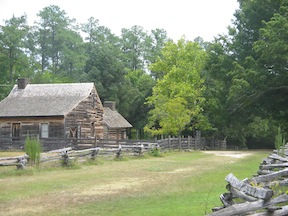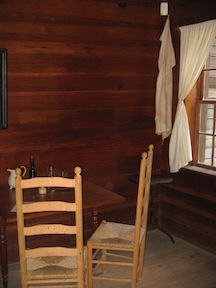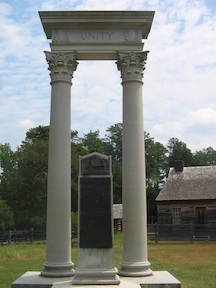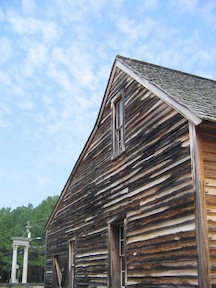The Road to Bennett Place
 The road to Bennett Place started for me, as it did for William T. Sherman and Joe Johnston, in Manassas.
The road to Bennett Place started for me, as it did for William T. Sherman and Joe Johnston, in Manassas.
Unlike the two army commanders, though, I’ve come here, to north-central North Carolina on the outskirts of Durham, with intent rather than through happenstance.
Sherman and Johnston found themselves on opposite sides at that great opening battle, Sherman as a colonel in command of a brigade of three-month volunteers and Johnston as commander of all Confederate forces.
From there, the war took them on different paths until the spring of 1864, when they clashed again outside Atlanta. By then, Sherman commanded all Union troops in the Western theater. Johnston, who’d been shuffled from command to command because of his poor relationship with Confederate President Jefferson Davis, had landed with the Army of Tennessee.
Sherman far outnumbered Johnston, who nonetheless led a skillful defensive campaign, although it eventually got him fired. Months later, after Sherman overran Johnston’s replacement and then ran roughshod over Georgia and South Carolina, Johnston came back to command for a final round. While he struck a blow at Bentonville, NC, Johnston knew there wasn’t much he could do to stop Sherman unless he united with Robert E. Lee’s beleaguered Army of Northern Virginia. Lee’s surrender to Grant at Appomattox made that option moot.
So that he could negotiate from strength, Johnston kept his own army together and far from Sherman’s reach. He hoped to secure terms for his men more favorable than the ones offered to Lee. Sherman, for his part, feared that Johnston would disperse his army into the mountains and carry on the war as a guerilla campaign—an option Sherman saw as disastrous—so he sought to do whatever he could to avoid that.
After a few rounds of shuttle diplomacy, the two men met along a forest road near Durham, midway between Johnston’s HQ in Greensboro and Sherman’s HQ in Raleigh. When Sherman asked Johnston if he knew of a place where they could confer privately, Johnston suggested a small farmhouse he and his staff had just passed.
 The home, owned by 59-year-old James Bennett—also spelled Bennitt—was a modest two-story building with a spacious common room, where the two generals sat down to hammer out terms. The pall of President Lincoln’s assassination hung over the table, but Sherman nonetheless offered sweepingly generous terms. He had no way of knowing that northern sentiment, hostile in the wake of Lincoln’s murder, would turn against him and his magnanimous offer. In fact, the terms were so generous, and sentiment so rancorous, that Grant was forced to pay a personal visit to his trusted subordinate.
The home, owned by 59-year-old James Bennett—also spelled Bennitt—was a modest two-story building with a spacious common room, where the two generals sat down to hammer out terms. The pall of President Lincoln’s assassination hung over the table, but Sherman nonetheless offered sweepingly generous terms. He had no way of knowing that northern sentiment, hostile in the wake of Lincoln’s murder, would turn against him and his magnanimous offer. In fact, the terms were so generous, and sentiment so rancorous, that Grant was forced to pay a personal visit to his trusted subordinate.
In the end, Sherman was forced to revise his offer so that it mirrored the terms Grant had extended at Appomattox, although Sherman also agreed to a supplementary set of conditions for Johnston’s men.
Sherman and Johnston met a total of three times at the Bennett’s farmhouse as they worked to finalize their agreement. On April 26, both men put pen to paper. Johnston surrendered all Confederate forces in the Carolinas, Georgia, and Florida—more than 89,000 in all—making it the largest surrender of the war.
It was not the last surrender, though. Richard Taylor would surrender in Alabama on May 4, Edmund Kirby Smith would surrender Trans-Mississippi forces on May 26, and Stand Watie would surrender in Indian Territory on June 23. The Confederate raider Shenandoah wouldn’t surrender until August.
 The grand vision for peace that Sherman and Johnston shared was commemorated at the site in 1923 with a memorial. Two columns support a block that says “Unity.” A bronze tablet, featuring a picture of the Bennett farmhouse, recounts the story.
The grand vision for peace that Sherman and Johnston shared was commemorated at the site in 1923 with a memorial. Two columns support a block that says “Unity.” A bronze tablet, featuring a picture of the Bennett farmhouse, recounts the story.
The farmhouse burned down in 1921, although the stone chimney survived. In the 1960s, to coincide with the Civil War’s centennial, the state of North Carolina reconstructed the farmhouse based on photographs and wartime sketches. The state now operates the facility as a state historic site.
The original road trace, lined by a snake-rail fence, still runs past the farmhouse. A kitchen and smokehouse stand nearby, and a fenced-in garden and a livestock corral, empty, sit quietly beyond.
As I walk from the visitor center, I listen to the crunch of my shoes on the gravel. I have the place to myself. Earlier, before I’d watched the orientation film and visited the small museum, a docent had led a handful of tourists around the property. The orientation he provided hadn’t been all that great, frankly, but at least he was friendly.
Fortunately, Bennett Place speaks for itself. I can hear its voices in the crunch of the gravel, the hollow clunk of the farmhouse’s front door closing, the imagine sound of footfalls on the house’s plank floor.
Some of the voices, like cavalry rivals Wade Hampton and Judson Kilpatrick, seethe and burn and snarl. Others, like Johnston’s, are quiet, firm, authoritative or, like Sherman’s, gruff yet reasonable—and, mayhaps, even pleasant.
I’ve come here today to hear these voices as they seek a way forward. Bennett Place is a place of surrender, of ending, but it is also a place of beginning. Not only did peace and unity begin here, so did a long friendship between Johnston and Sherman.
 For me, this spot also represents a beginning. I’m about to launch into a new phase of my Civil War career—which began some thirteen years ago on Henry Hill—as a blogger. I wanted something new, something big, to help me get in the right mindset.
For me, this spot also represents a beginning. I’m about to launch into a new phase of my Civil War career—which began some thirteen years ago on Henry Hill—as a blogger. I wanted something new, something big, to help me get in the right mindset.
And what could be bigger than the future? As “Old Joe” Johnston and “Uncle Billy” Sherman sat at that table, affixing their names to bold, hopeful ideas, I can hear them talking—and I share their optimism.
What a great out of the way spot. It’s truely a place to reflect on the war. You brought that to life.
And if you check the records of the Southern Claims Commission, you’ll find that James Bennett was NOT compensated for the walnut table (and it’s oil cloth cover) that a souvenir hunting Union Captain took out of his parlor in April 1965.